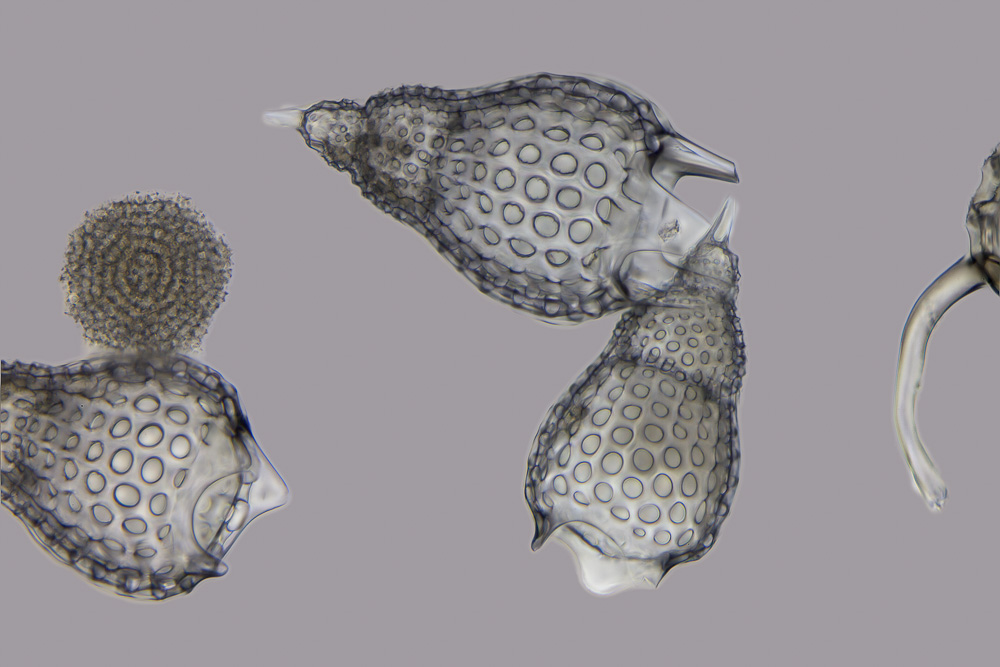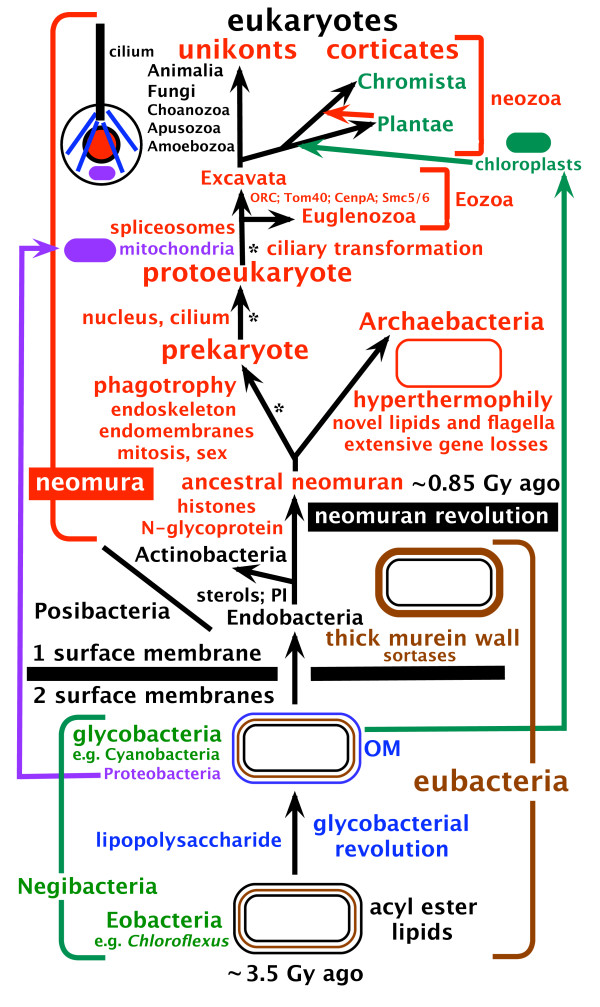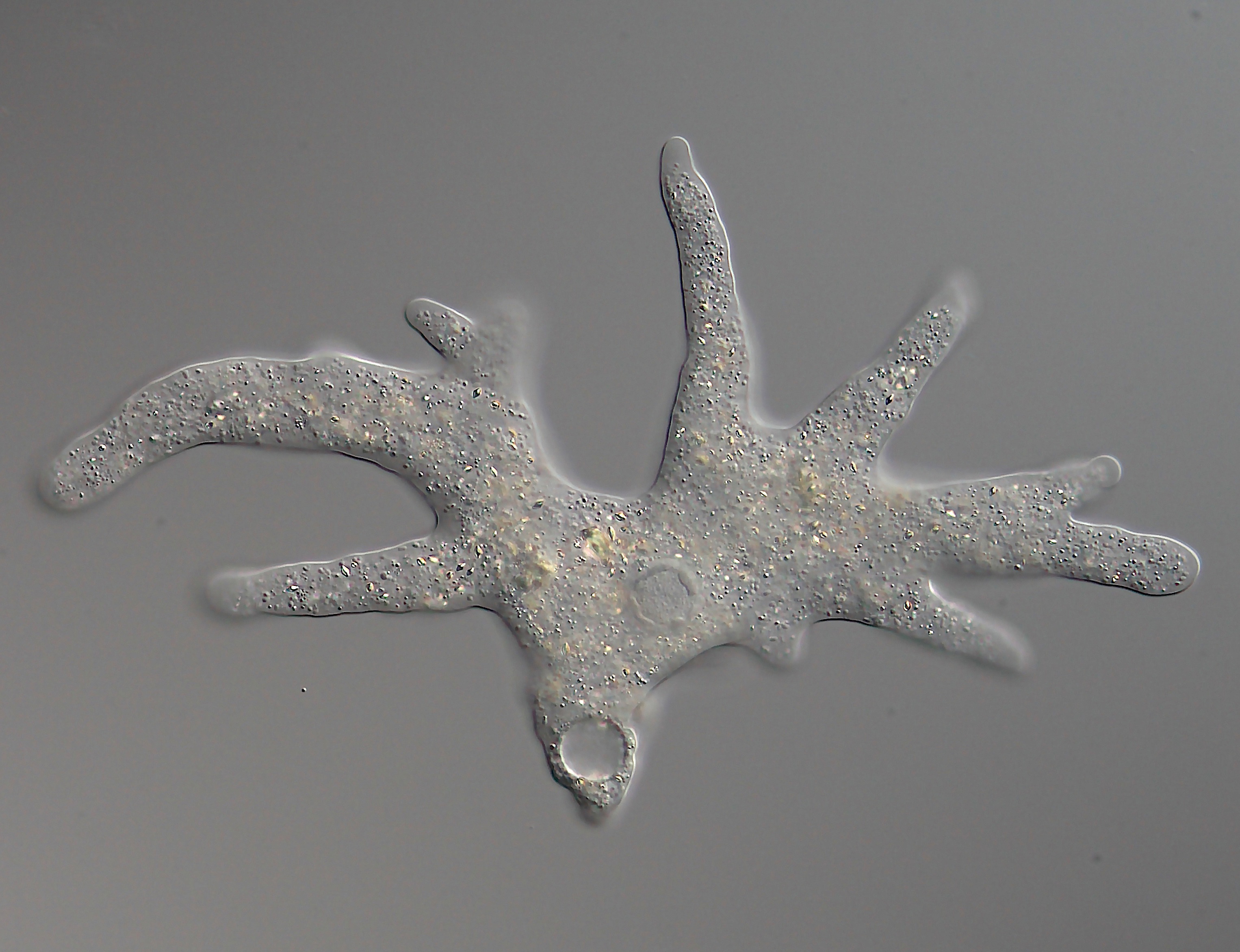|
Radiozoa
The Radiolaria, also called Radiozoa, are protozoa of diameter 0.1–0.2 mm that produce intricate mineral skeletons, typically with a central capsule dividing the cell into the inner and outer portions of endoplasm and ectoplasm. The elaborate mineral skeleton is usually made of silica. They are found as zooplankton throughout the global ocean. As zooplankton, radiolarians are primarily heterotrophic, but many have photosynthetic endosymbionts and are, therefore, considered mixotrophs. The skeletal remains of some types of radiolarians make up a large part of the cover of the ocean floor as siliceous ooze. Due to their rapid change as species and intricate skeletons, radiolarians represent an important diagnostic fossil found from the Cambrian onwards. Description Radiolarians have many needle-like pseudopods supported by bundles of microtubules, which aid in the radiolarian's buoyancy. The cell nucleus and most other organelles are in the endoplasm, while the ectopl ... [...More Info...] [...Related Items...] OR: [Wikipedia] [Google] [Baidu] |
Phaeodaria
Phaeodarea, or Phaeodaria, is a group of amoeboid cercozoan organisms. They are traditionally considered radiolarians, but in molecular trees do not appear to be close relatives of the other groups, and are instead placed among the Cercozoa. They are distinguished by the structure of their central capsule and by the presence of a phaeodium, an aggregate of waste particles within the cell. The term "Radiozoa" has been used to refer to radiolaria when Phaeodarea is explicitly excluded. Phaeodarea produce hollow skeletons composed of amorphous silica and organic material, which rarely fossilize. The endoplasm is divided by a cape with three openings, of which one gives rise to feeding pseudopods, and the others let through bundles of microtubules that support the axopods. Unlike true radiolarians, there are no cross-bridges between them. They also lack symbiotic algae, generally living below the photic zone, and do not produce any strontium sulphate. Taxonomy Phylogeny Through p ... [...More Info...] [...Related Items...] OR: [Wikipedia] [Google] [Baidu] |
Thomas Cavalier-Smith
Thomas (Tom) Cavalier-Smith, FRS, FRSC, NERC Professorial Fellow (21 October 1942 – 19 March 2021), was a professor of evolutionary biology in the Department of Zoology, at the University of Oxford. His research has led to discovery of a number of unicellular organisms (protists) and advocated for a variety of major taxonomic groups, such as the Chromista, Chromalveolata, Opisthokonta, Rhizaria, and Excavata. He was known for his systems of classification of all organisms. Life and career Cavalier-Smith was born on 21 October 1942 in London. His parents were Mary Maude (née Bratt) and Alan Hailes Spencer Cavalier Smith. He was educated at Norwich School, Gonville and Caius College, Cambridge (MA) and King's College London (PhD). He was under the supervision of Sir John Randall for his PhD thesis between 1964 and 1967; his thesis was entitled "''Organelle Development in'' Chlamydomonas reinhardii". From 1967 to 1969, Cavalier-Smith was a guest investigato ... [...More Info...] [...Related Items...] OR: [Wikipedia] [Google] [Baidu] |
Collodaria
Collodaria is a unicellular order (organisms within the order are called Collodarians) under the phylum Radiozoa (or Radiolaria) and the infrakingdom Rhizaria. Like most of the Radiolaria taxonomy, Collodaria was first described by Ernst Haeckel, a German scholar who published three volumes of manuscript describing the extensive samples of Radiolaria collected by the voyage of HMS ''Challenger''. Recent molecular phylogenetic studies concluded that there are Collodaria contains three families, Sphaerozodae, Collosphaeridae, and Collophidilidae. Story and origin Ernst Haeckel is the main contributor to species description in the phylum Radiolaria, which contains the order Collodaria. Members of Collodaria were first described in 1862. In 1881, ''Collodaria'' was defined by Haeckel in 1881 as “Spumellaria without latticed shell.” The story behind this order involved the historic voyage of HMS ''Challenger''. As recorded in the manuscript of "Report on the Scientific Resul ... [...More Info...] [...Related Items...] OR: [Wikipedia] [Google] [Baidu] |
Challenger Expedition
The ''Challenger'' expedition of 1872–1876 was a scientific program that made many discoveries to lay the foundation of oceanography. The expedition was named after the naval vessel that undertook the trip, . The expedition, initiated by William Benjamin Carpenter, was placed under the scientific supervision of Sir Charles Wyville Thomson—of the University of Edinburgh and Merchiston Castle School—assisted by five other scientists, including Sir John Murray, a secretary-artist and a photographer. The Royal Society of London obtained the use of ''Challenger'' from the Royal Navy and in 1872 modified the ship for scientific tasks, equipping it with separate laboratories for natural history and chemistry. The expedition, led by Captain George Nares, sailed from Portsmouth, England, on 21 December 1872. Other naval officers included Commander John Maclear. – pages 19 and 20 list the civilian staff and naval officers and crew, along with changes that took place during the ... [...More Info...] [...Related Items...] OR: [Wikipedia] [Google] [Baidu] |
Heterotroph
A heterotroph (; ) is an organism that cannot produce its own food, instead taking nutrition from other sources of organic carbon, mainly plant or animal matter. In the food chain, heterotrophs are primary, secondary and tertiary consumers, but not producers. Living organisms that are heterotrophic include all animals and fungi, some bacteria and protists, and many parasitic plants. The term heterotroph arose in microbiology in 1946 as part of a classification of microorganisms based on their type of nutrition. The term is now used in many fields, such as ecology in describing the food chain. Heterotrophs may be subdivided according to their energy source. If the heterotroph uses chemical energy, it is a chemoheterotroph (e.g., humans and mushrooms). If it uses light for energy, then it is a photoheterotroph (e.g., green non-sulfur bacteria). Heterotrophs represent one of the two mechanisms of nutrition (trophic levels), the other being autotrophs (''auto'' = self, ''troph'' = ... [...More Info...] [...Related Items...] OR: [Wikipedia] [Google] [Baidu] |
Endosymbiont
An ''endosymbiont'' or ''endobiont'' is any organism that lives within the body or cells of another organism most often, though not always, in a mutualistic relationship. (The term endosymbiosis is from the Greek: ἔνδον ''endon'' "within", σύν ''syn'' "together" and βίωσις ''biosis'' "living".) Examples are nitrogen-fixing bacteria (called rhizobia), which live in the root nodules of legumes, single-cell algae inside reef-building corals and bacterial endosymbionts that provide essential nutrients to insects. There are two types of symbiont transmissions. In horizontal transmission, each new generation acquires free living symbionts from the environment. An example is the nitrogen-fixing bacteria in certain plant roots. Vertical transmission takes place when the symbiont is transferred directly from parent to offspring. It is also possible for both to be involved in a mixed-mode transmission, where symbionts are transferred vertically for some generation bef ... [...More Info...] [...Related Items...] OR: [Wikipedia] [Google] [Baidu] |
Mixotroph
A mixotroph is an organism that can use a mix of different sources of energy and carbon, instead of having a single trophic mode on the continuum from complete autotrophy at one end to heterotrophy at the other. It is estimated that mixotrophs comprise more than half of all microscopic plankton. There are two types of eukaryotic mixotrophs: those with their own chloroplasts, and those with endosymbionts—and those that acquire them through kleptoplasty or by enslaving the entire phototrophic cell. Possible combinations are photo- and chemotrophy, litho- and organotrophy (osmotrophy, phagotrophy and myzocytosis), auto- and heterotrophy or other combinations of these. Mixotrophs can be either eukaryotic or prokaryotic. They can take advantage of different environmental conditions. If a trophic mode is obligate, then it is always necessary for sustaining growth and maintenance; if facultative, it can be used as a supplemental source. Some organisms have incomplete Calvin cycles, s ... [...More Info...] [...Related Items...] OR: [Wikipedia] [Google] [Baidu] |
Siliceous Ooze
Siliceous ooze is a type of biogenic pelagic sediment located on the deep ocean floor. Siliceous oozes are the least common of the deep sea sediments, and make up approximately 15% of the ocean floor. Oozes are defined as sediments which contain at least 30% skeletal remains of pelagic microorganisms. Siliceous oozes are largely composed of the silica based skeletons of microscopic marine organisms such as diatoms and radiolarians. Other components of siliceous oozes near continental margins may include terrestrially derived silica particles and sponge spicules. Siliceous oozes are composed of skeletons made from opal silica Si(O2), as opposed to calcareous oozes, which are made from skeletons of calcium carbonate organisms (i.e. coccolithophores). Silica (Si) is a bioessential element and is efficiently recycled in the marine environment through the silica cycle. Distance from land masses, water depth and ocean fertility are all factors that affect the opal silica content in sea ... [...More Info...] [...Related Items...] OR: [Wikipedia] [Google] [Baidu] |
Fossil
A fossil (from Classical Latin , ) is any preserved remains, impression, or trace of any once-living thing from a past geological age. Examples include bones, shells, exoskeletons, stone imprints of animals or microbes, objects preserved in amber, hair, petrified wood and DNA remnants. The totality of fossils is known as the ''fossil record''. Paleontology is the study of fossils: their age, method of formation, and evolutionary significance. Specimens are usually considered to be fossils if they are over 10,000 years old. The oldest fossils are around 3.48 billion years old to 4.1 billion years old. Early edition, published online before print. The observation in the 19th century that certain fossils were associated with certain rock strata led to the recognition of a geological timescale and the relative ages of different fossils. The development of radiometric dating techniques in the early 20th century allowed scientists to quantitatively measure the ... [...More Info...] [...Related Items...] OR: [Wikipedia] [Google] [Baidu] |
Microtubule
Microtubules are polymers of tubulin that form part of the cytoskeleton and provide structure and shape to eukaryotic cells. Microtubules can be as long as 50 micrometres, as wide as 23 to 27 nm and have an inner diameter between 11 and 15 nm. They are formed by the polymerization of a dimer of two globular proteins, alpha and beta tubulin into protofilaments that can then associate laterally to form a hollow tube, the microtubule. The most common form of a microtubule consists of 13 protofilaments in the tubular arrangement. Microtubules play an important role in a number of cellular processes. They are involved in maintaining the structure of the cell and, together with microfilaments and intermediate filaments, they form the cytoskeleton. They also make up the internal structure of cilia and flagella. They provide platforms for intracellular transport and are involved in a variety of cellular processes, including the movement of secretory vesicles, organell ... [...More Info...] [...Related Items...] OR: [Wikipedia] [Google] [Baidu] |
Pseudopod
A pseudopod or pseudopodium (plural: pseudopods or pseudopodia) is a temporary arm-like projection of a eukaryotic cell membrane that is emerged in the direction of movement. Filled with cytoplasm, pseudopodia primarily consist of actin filaments and may also contain microtubules and intermediate filaments. Pseudopods are used for motility and ingestion. They are often found in amoebas. Different types of pseudopodia can be classified by their distinct appearances. Lamellipodia are broad and thin. Filopodia are slender, thread-like, and are supported largely by microfilaments. Lobopodia are bulbous and amoebic. Reticulopodia are complex structures bearing individual pseudopodia which form irregular nets. Axopodia are the phagocytosis type with long, thin pseudopods supported by complex microtubule arrays enveloped with cytoplasm; they respond rapidly to physical contact. Some pseudopodial cells are able to use multiple types of pseudopodia depending on the situation: Most of ... [...More Info...] [...Related Items...] OR: [Wikipedia] [Google] [Baidu] |
Silicon Dioxide
Silicon dioxide, also known as silica, is an oxide of silicon with the chemical formula , most commonly found in nature as quartz and in various living organisms. In many parts of the world, silica is the major constituent of sand. Silica is one of the most complex and most abundant families of materials, existing as a compound of several minerals and as a synthetic product. Notable examples include fused quartz, fumed silica, silica gel, opal and aerogels. It is used in structural materials, microelectronics (as an electrical insulator), and as components in the food and pharmaceutical industries. Structure In the majority of silicates, the silicon atom shows tetrahedral coordination, with four oxygen atoms surrounding a central Si atomsee 3-D Unit Cell. Thus, SiO2 forms 3-dimensional network solids in which each silicon atom is covalently bonded in a tetrahedral manner to 4 oxygen atoms. In contrast, CO2 is a linear molecule. The starkly different structures of the dioxid ... [...More Info...] [...Related Items...] OR: [Wikipedia] [Google] [Baidu] |




.jpg)



